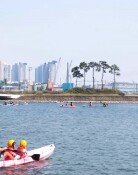A heartfelt and valuable
A heartfelt and valuable
Posted June. 13, 2017 07:15,
Updated June. 13, 2017 07:19
Seoul has a new horizontal landmark -- "Seoullo 7017," an overpass-turned-park opened last month. While many think a landmark is a high rise, a low-rise horizontal landmark with an easy access to people is getting attention.
Seoullo 7017 seems to have demonstrated the zeitgeist of urban regeneration in that it is not about removal but regeneration, not a street but a pedestrian road, and not vertical but horizontal. It remains doubtful, however, whether it will give an impression other than curiosity to visitors because it has no story with it.
New York’s High Line Park, which Seoullo 7017 modelled after, has a dramatic story behind it. It was originally a nine-meter high railroad for cargo trains running through Manhattan. The New York City decided to remove the hideous structure, and held a public hearing in 1999. Unexpectedly, some wanted to keep it at the hearing where two young men decided to preserve the facility, objecting to the idea to remove it.
They held many gatherings to increase supporters and raised funds. They filed a lawsuit to nullify the city’s decision for removal and garnered support from officials based on the study that making it into a park is more profitable than removing it. They persuaded people who opposed the idea due to their property near the railroad by offering them a right to develop other area. The 9/11 attack in 2001 threw a curve ball to the movement. New Yorkers healed the sense of loss by joining the movement instead. Ten years later, the High Line Park finally opened in June 2009 despite many twists and turns. With a pin reading “I saved the High Line,” some 1,000 New Yorkers were pleased about the opening, saying, “Dreams come true in New York.”
If the High Line is made bottom-up, Seoullo 7017 is a top-down development project led by the government. The High Line movement was the result of a series of discussions – Is it worth keeping it? If so, how can we use it? How can we cover the expenses and who will operate this? The 60 billion won (53 million dollars) Seoullo project was announced by Seoul Mayor Park Won-soon in September 2014 and completed in less than three years.
Winy Mass, a Dutch architect who designed the overpass park, said to Korean media, “(Mayor Park said) he couldn’t wait for a long time. He stressed the importance of execution. I was really surprised at the unimaginable speed.” He added, “It would have taken about a decade in other countries. Many things have been missed out to meet the deadline."
What the Dutch architect felt missing pale comparison to what Seoul citizens missed at the expense of the surprising speed. How many people would feel proud that they saved the overpass, watching Seoullo 7017? People would rather be curious about Mayor Park’s plan for presidential election, saying former Seoul Mayor and former President Lee Myung-bak restored Chunggyecheon Stream and (incumbent Seoul Mayor) Park Won-soon Seoullo.” Regeneration is more difficult than creating a new thing because it involves more stakeholders. Seoul citizens lost a chance to learn from how to reach an agreement by coordinating different views.
A good-looking landmark structure does not make a city competitive. The process makes the city more attractive when it becomes part of the lives of people and the completion of the landmark gives a sense of accomplishment to people. I would like to deliver a message from the High Line movement to Korean politicians who want to become famous by building a landmark within their term while not caring about taxpayers’ money. “(A public project) can become more successful by giving credit to more people for the success.”







